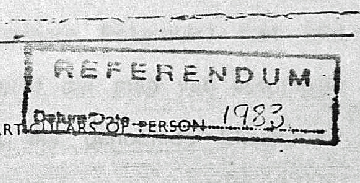South African Constitutional Reform Referendum, 1983 on:
[Wikipedia]
[Google]
[Amazon]
 A referendum on a new constitution was held in
A referendum on a new constitution was held in
 A referendum on a new constitution was held in
A referendum on a new constitution was held in South Africa
South Africa, officially the Republic of South Africa (RSA), is the Southern Africa, southernmost country in Africa. Its Provinces of South Africa, nine provinces are bounded to the south by of coastline that stretches along the Atlantic O ...
on 2 November 1983 in which the white
White is the lightest color and is achromatic (having no chroma). It is the color of objects such as snow, chalk, and milk, and is the opposite of black. White objects fully (or almost fully) reflect and scatter all the visible wa ...
population was given the opportunity to approve or reject the Constitution of 1983. This constitution introduced the Tricameral Parliament, in which Coloured and Indian South Africans would be represented in separate parliamentary chambers, while black Africans, who were the majority of South Africa's population, would remain unrepresented. The referendum passed with 66.3% of voters voting "Yes"; consequently the new constitution came into force on 3 September 1984.
Background
In 1981 theSenate
A senate is a deliberative assembly, often the upper house or chamber of a bicameral legislature. The name comes from the ancient Roman Senate (Latin: ''Senatus''), so-called as an assembly of the senior (Latin: ''senex'' meaning "the el ...
was abolished and replaced with the President's Council, which was an advisory body consisting of sixty nominated members from the white, coloured, Indian and Chinese population groups. Following a request by Prime Minister P.W. Botha, the President's Council presented a set of proposals in 1982 for constitution
A constitution is the aggregate of fundamental principles or established precedents that constitute the legal basis of a polity, organization or other type of entity, and commonly determines how that entity is to be governed.
When these pri ...
al and political reform. This proposal called for the implementation of "power sharing" between the white, coloured and Indian communities.
The right wing of the ruling National Party (NP) rejected this proposal and a group of its MPs, led by Dr. Andries Treurnicht, a cabinet minister
A minister is a politician who heads a ministry, making and implementing decisions on policies in conjunction with the other ministers. In some jurisdictions the head of government is also a minister and is designated the ' prime minister', ' p ...
and the leader of the NP in the Transvaal province, broke away to form the Conservative Party (CP) in order to fight for a return to apartheid
Apartheid ( , especially South African English: , ; , ) was a system of institutionalised racial segregation that existed in South Africa and South West Africa (now Namibia) from 1948 to the early 1990s. It was characterised by an ...
in its original form. However, Botha continued to be in favour of implementing the President's Council proposal and in 1983 the NP government introduced a new constitutional framework. A referendum was called for in order to determine public support for the reforms amongst white voters. The New Republic Party led by Vause Raw supported the new constitution, although it continued to call for black representation in Parliament.
Opposition
Both the Progressive Federal Party (PFP), which objected to the exclusion of blacks, as well as the CP, which objected to the participation of coloureds and Indians, campaigned for a "No" vote. However, many PFP followers and parts of the anti-governmentEnglish language
English is a West Germanic language that developed in early medieval England and has since become a English as a lingua franca, global lingua franca. The namesake of the language is the Angles (tribe), Angles, one of the Germanic peoples th ...
press supported the new constitution as "a step in the right direction". The conservative opposition to the reforms used banners with the text " Rhodesia voted yes – vote no!" reflecting on the transformation to majority rule in Rhodesia
Rhodesia ( , ; ), officially the Republic of Rhodesia from 1970, was an unrecognised state, unrecognised state in Southern Africa that existed from 1965 to 1979. Rhodesia served as the ''de facto'' Succession of states, successor state to the ...
.
The response of Coloured, Indian and black leaders were mixed. The new constitution was rejected by most Bantustan leaders and the Urban Councils Association of South Africa (representing the black township administrations) because it did not provide for black representation. Coloured and Indian parties that intended to participate in the Tricameral Parliament but also insisted on extending representation to the black majority.
The United Democratic Front (UDF) was launched as a non-racial coalition to oppose the referendum and the subsequent elections for the coloured and Indian chambers in parliament.
Results
By region
For counting purposes the provinces of South Africa were divided into various referendum areas. The following table shows the results in each area.References
{{Political history of South Africa Referendums in South Africa ConstitutionalSouth Africa
South Africa, officially the Republic of South Africa (RSA), is the Southern Africa, southernmost country in Africa. Its Provinces of South Africa, nine provinces are bounded to the south by of coastline that stretches along the Atlantic O ...
Constitutional referendums
South Africa
South Africa, officially the Republic of South Africa (RSA), is the Southern Africa, southernmost country in Africa. Its Provinces of South Africa, nine provinces are bounded to the south by of coastline that stretches along the Atlantic O ...
Apartheid in South Africa
Apartheid government
Suffrage